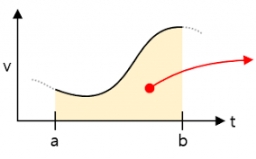A particle
A particle moves in a straight line so that its velocity (m/s) at time t seconds is given by v(t) = 3t2-4t-4, t > 0.
Initially, the particle is 8 meters from a fixed origin's right.
After how many seconds is the particle at the origin?
Initially, the particle is 8 meters from a fixed origin's right.
After how many seconds is the particle at the origin?
Final Answer:

Tips for related online calculators
Do you want to convert velocity (speed) units?
Do you want to convert time units like minutes to seconds?
Do you want to convert time units like minutes to seconds?
You need to know the following knowledge to solve this word math problem:
basic operations and conceptsUnits of physical quantitiesthemes, topicsGrade of the word problem
Related math problems and questions:
- Simultaneously 82583
 The crane lifts the load in a uniform, straight line to a height of 8 m and simultaneously moves in a horizontal direction to a distance of 6 m. What path did the load cover? What was the resulting velocity of the load if it took 50 seconds to move it
The crane lifts the load in a uniform, straight line to a height of 8 m and simultaneously moves in a horizontal direction to a distance of 6 m. What path did the load cover? What was the resulting velocity of the load if it took 50 seconds to move it - Phone numbers
 How many 9-digit telephone numbers can be compiled from the digits 0,1,2,..,8,9 that no digit is repeated?
How many 9-digit telephone numbers can be compiled from the digits 0,1,2,..,8,9 that no digit is repeated? - Acceleration - free fall
 How long will it take for a car to reach speed of 180 km/h with an acceleration of 10 m/s²?
How long will it take for a car to reach speed of 180 km/h with an acceleration of 10 m/s²? - Direction vector
 The line p is given by the point P [- 0,5; 1] and the direction vector s = (1,5; - 3) determines: A) value of parameter t for points X [- 1,5; 3], Y [1; - 2] lines p B) whether the points R [0,5; - 1], S [1,5; 3] lie on the line p C) parametric equations
The line p is given by the point P [- 0,5; 1] and the direction vector s = (1,5; - 3) determines: A) value of parameter t for points X [- 1,5; 3], Y [1; - 2] lines p B) whether the points R [0,5; - 1], S [1,5; 3] lie on the line p C) parametric equations - Constant Angular Acceleration
 The particle began to move from rest along a circle with a constant angular acceleration. After five cycles (n = 5), its angular velocity reached the value ω = 12 rad/s. Calculate the magnitude of the angular acceleration ε of this motion and the time int
The particle began to move from rest along a circle with a constant angular acceleration. After five cycles (n = 5), its angular velocity reached the value ω = 12 rad/s. Calculate the magnitude of the angular acceleration ε of this motion and the time int - Distance 2469
 How many seconds will the car cover a distance of 50 meters at a speed of 100 km/h?
How many seconds will the car cover a distance of 50 meters at a speed of 100 km/h? - Perpendicular 82994
 The straight line p is given by the formula y = 1/2 x - 1 . The line q is perpendicular to the line p and passes through the point A [1; 5]. Determine the y-coordinate of the point that intersects the line q with the y-axis.
The straight line p is given by the formula y = 1/2 x - 1 . The line q is perpendicular to the line p and passes through the point A [1; 5]. Determine the y-coordinate of the point that intersects the line q with the y-axis.
